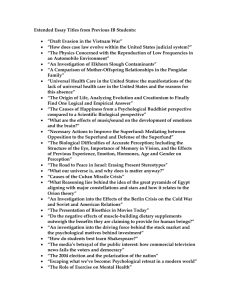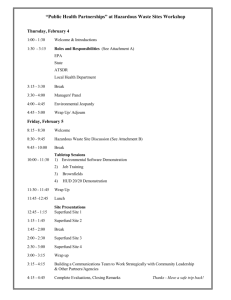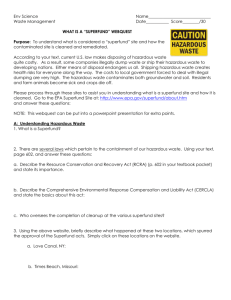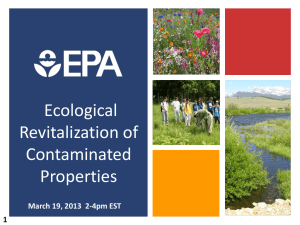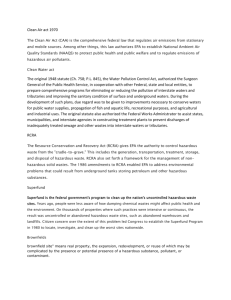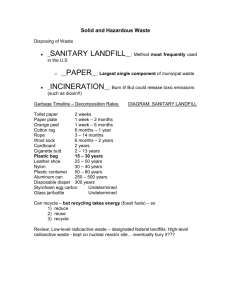Introduction to Superfund - UNC Gillings School of Global Public
advertisement
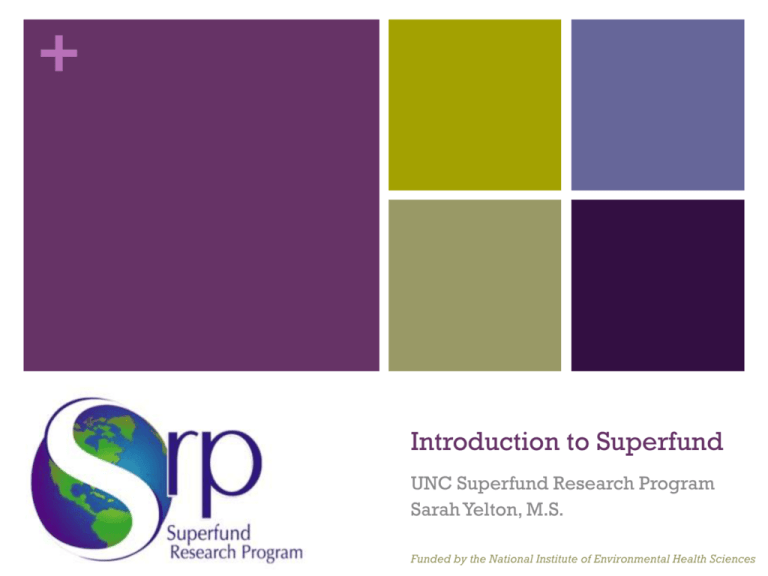
+ Introduction to Superfund UNC Superfund Research Program Sarah Yelton, M.S. Funded by the National Institute of Environmental Health Sciences + Central Questions What is a hazardous waste site? What is a Superfund Site? How can you identify these sites in your community? How is hazardous waste cleaned up? How can you incorporate Superfund topics into your classroom? + According to the EPA… One in four Americans lives within 4 miles of a hazardous waste site, yet many US citizens are unaware of these sites and their implications for human health. To search for EPA clean-up sites in your community: http://www.epa.gov/cimc + Cleanups in My Community a mapping and listing tool that shows where pollution is being or has been cleaned up under EPA's Superfund, RCRA and/or Brownfields cleanup programs. + What is Superfund? Also known as the Comprehensive Environmental Response, Compensation and Liability Act (CERCLA). Established by Congress in 1980 to clean up the country’s worst hazardous waste sites; Locates, investigates, cleans up and monitors hazardous waste sites throughout the US; Works with communities to return hazardous waste sites to safe and productive sites; Administered through the Environmental Protection Agency in cooperation with state and tribal governments. Source: EPA, http://www.epa.gov/superfund/index.htm + What is a Superfund Site? “A Superfund site is any land in the United States that has been contaminated by hazardous waste and identified by the Environmental Protection Agency (EPA) as a candidate for cleanup because it poses a risk to human health and/or the environment.” - US Environmental Protection Agency + The ATSDR 2013 Substance Priority List ARSENIC LEAD MERCURY VINYL CHLORIDE POLYCHLORINATED BIPHENYLS BENZENE CADMIUM BENZO(A)PYRENE POLYCYCLIC AROMATIC HYDROCARBONS These substances are most commonly found at facilities on the National Priorities List (NPL) and are determined to pose the most significant potential threat to human health due to their known or suspected toxicity and potential for human exposure at these NPL sites. http://www.atsdr.cdc.gov/SPL/index.html + Toxic Chemicals Can: Interact with macromolecules within the body Impair or inhibit metabolic processes Induce mutations in DNA (mutagenic) May increase the risk of cancer by altering cellular metabolism or damaging DNA directly (carcinogenic) Impair reproduction Induce birth defects (teratogenic) + How do we measure contaminants? The concentration of a contaminant in water or soil is often reported in parts or million (ppm) or parts per billion (ppb). Toxic chemicals present in even ppm or ppb amounts can be harmful to human health. + Bioaccumulation vs Biomagnification Bioaccumulation Concentration of a pollutant within an organism Body Burden refers to the amount of pollution present in an organism Pollution of the human body begins before birth Biomagnification Concentration of a pollutant within a food chain PCBs, DDT, Mercury, Arsenic, Dioxin + http://www.seathos.org/what-is-bio-magnification/ + National Priority List (NPL) Superfund Sites Site Status as of July 22, 2014 51 sites proposed for the NPL 1319 NPL sites 1158 NPL sites with physical cleanup construction completed 382 deleted sites http://www.epa.gov/superfund/sites/query/queryhtm/npltotal.htm North Carolina National Priority List of Superfund sites (July 2014) 42 sites: 39 final; 3 deleted http://www.epa.gov/superfund/sites/npl/where.htm http://www.epa.gov/superfund/sites/npl/status.htm + Hazardous Waste: How do we Clean it Up? “Dredging of Pollutants Begins in Hudson” New York Times, May 15, 2009 + Superfund Clean Up Timeline Discovery of Contaminated Site Preliminary Assessment/Inspection NPL Site Listing Process Remedial Investigation/Feasibility Study Records of Decision Remedial Design & Action Construction Completion NPL Deletion Site Reuse/Redevelopment =Clean-Up + Remediation of contaminated soil Remediation Use a detergent to clean contaminated soil Thermal desorption Isolate contaminated area Concrete dikes Cap with impervious layers of plastic/clay Bioremediation Allow natural processes to breakdown contaminant Biostimulation + Soil Remediation Challenges Underground Ground water moves 1 meter/yr Many complex interactions with soil constituents Expensive! www.epa.gov/.../sites/PAD003058047/photos.htm + Remediation of contaminated water Surface Water Prevent spreading Skim contaminant from surface Mix and aerate to promote natural clean up Clean up contaminated sediments Dredge Place a cover over them Allow natural processes to break them down Allow natural processes to breakdown contaminant + Remediation of contaminated water Groundwater Pump and treat and return to ground Containment Allow natural processes to breakdown contaminant + Who pays for Superfund cleanup? Until 1995, funded by a tax on petroleum and chemical industries $1.6 billion was collected and the tax went to a trust fund for cleaning up abandoned or uncontrolled hazardous waste sites. Trust fund was exhausted by the end of FY 2003 Potentially Responsible Parties (PRPs) are first in line, if they can be identified If no PRPs identified, funds can be appropriated by Congress out of general revenues + Superfund in the Classroom “Students read background information about Superfund; discuss relevant Superfund sites in NC.” Stacy Rinehart, 7th grade science, Wake County Schools “Working in groups, students research different Superfund sites in NC. Students use worksheets to simplify the technical information.” John Cardarelli, 6th grade science, Winston Salem Schools + Investigating a Superfund Site of Interest Superfund Sites, EPA Region 4 http://www.epa.gov/region04 /superfund/sites/sites.html +Investigating a Superfund Site of Interest + + Superfund in the Classroom How might you use this website inquiry with students? How might you incorporate this site into your class (e.g., guest speaker, etc.)? How have you covered Superfund and/or hazardous waste topics with your class in the past? + UNC Superfund Research Program Advances the scientific knowledge required to understand and reduce risks to human health associated with several of the highest priority chemicals regulated under the Superfund program, namely polycyclic aromatic hydrocarbons (PAHs) and chlorinated hydrocarbons (TCE and PCB). + UNC Superfund Research Program Faculty Research Projects: Biomedical Toxicity caused by Oxidative Stress (e.g., DNA Damage) Toxicity of Trichloroethylene (TCE) Cadmium Induced Toxicity Cleanup Research Projects (Remediation) Research Projects Bioremediation of PAH contaminated soil Bioavailability of toxic compounds in water and sediment + Biomedical Research How dioxins and polychlorinated biphenyls (PCBs ) damage DNA Metabolism of trichloroethylene (TCE) in the body Influence of maternal cadmium exposure on newborn birth weight + Remediation (Cleanup) Research How well PAH-contaminated soil is cleaned up using bioremediation Development of passive sampling devices to measure longer term environmental exposures + Research Translation Getting Science into Application + Dr. Rebecca Fry: Toxic Metals and Your Health Studies the relationship between toxic metals in the environment and detrimental health effects, particularly in children. Studying children’s health effects related to prenatal exposure to cadmium in North Carolina With DHHS, mapped the presence of toxic metals in well water throughout the state + Toxic metals: Arsenic Is there the potential for exposure in North Carolina? Is there the potential for exposure in vulnerable populations? Is there a risk of exposure from food? How do metals impact our health? + Arsenic occurs naturally 20th most abundant metal in the Earth’s crust A known multiple organ carcinogen Non-cancer endpoints + Sources of arsenic Treated wood Pesticides or herbicides Industrial by-products Smelting Coal Emissions Food Juices, Rice, Seafood Drinking water + Arsenic: continues to poison the water of millions around the globe Smedley, Pauline L.. 2008 Sources and distribution of arsenic in groundwater and aquifers. In: Appelo, Tony, (ed.) Arsenic in Groundwater : a World Problem. British Geological Survey +More than 2.3 million people in N. Carolina use water from private, unregulated wells 2009 75,000 people >63,000 wells over 10 yrs 1436 wells >10 ppb Hundreds > 50 ppb Max=800 ppb Sanders et al. Environ Int 201 Smedley, Pauline L.. 2008 Sources and distribution of arsenic in groundwater and aquifers. In: Appelo, Tony, (ed.) Arsenic in Groundwater : a World Problem. British Geological Survey + Arsenic concentration (2009) Sanders, A.P, et al. (2011) Arsenic in North Carolina: Public Health Implications, Environment International, Vol. 38 pp. 10-16 + Arsenic in NC (10 yr avg) +More than 2.3 million people in N. Carolina use water from private, unregulated wells 2009 for There is the potential toxic metals exposure via private water 75,000well people >63,000 wells over 10 yrs 1436 wells >10 ppb Hundreds > 50 ppb Max=800 ppb Sanders et al. Environ Int 201 Smedley, Pauline L.. 2008 Sources and distribution of arsenic in groundwater and aquifers. In: Appelo, Tony, (ed.) Arsenic in Groundwater : a World Problem. British Geological Survey + Toxic metals are detectable in pregnant women in North Carolina Mercury: 5 exceed pregnancy level of concern (3.5 ug/L) Lead: 1 exceeds CDC pregnant women advisory (5 ug/dL) Sanders et al. Plos One 2012 + Toxic metals are detectable in pregnant women in North Carolina Some of the samples from pregnant women in North Carolina indicate exposure to toxic metals Mercury: 5 exceed pregnancy level of concern (3.5 ug/L) Lead: 1 exceeds CDC pregnant women advisory (5 ug/dL) Sanders et al. Plos One 2012 + Health effects of prenatal arsenic exposure Newborn health effects related to maternal exposure to arsenic include increased risk of spontaneous abortion, stillbirth, preterm birth, low birth weight, and infant mortality (reviewed by Vahter, 2008) Prenatal and early life exposure to arsenic is associated with adult onset disease Cancer and non-cancer endpoints Gene expression is + What can YOU do? Test Your Well! + Making Superfund Relevant Share relevant scientific concepts and societal issues with students Connect industrial hazardous waste to household hazardous waste to help empower students to improve their immediate environment Ample resources and curricula to support your teaching + http://www.sph.unc.edu/srp/ + http://www.epa.gov/superfund/ + Haz-ED http://www.epa.gov/superfund/students/clas_act/haz-ed/hazindex.htm + Citizen’s Guide to Clean Up Technologies http://www.clu-in.org/products/citguide/ + Cleaning Up Contaminated Sites http://www.epa.gov/superfund/students/wastsite/index.htm + NY Times Topics: Superfund http://topics.nytimes.com/top/reference/timestopics/subjects/s/superfund/index.html + Contact Information Superfund Research Program University of North Carolina at Chapel Hill http://www.sph.unc.edu/srp/ Sarah Yelton (919) 966-0895 sarah.yelton@unc.edu
